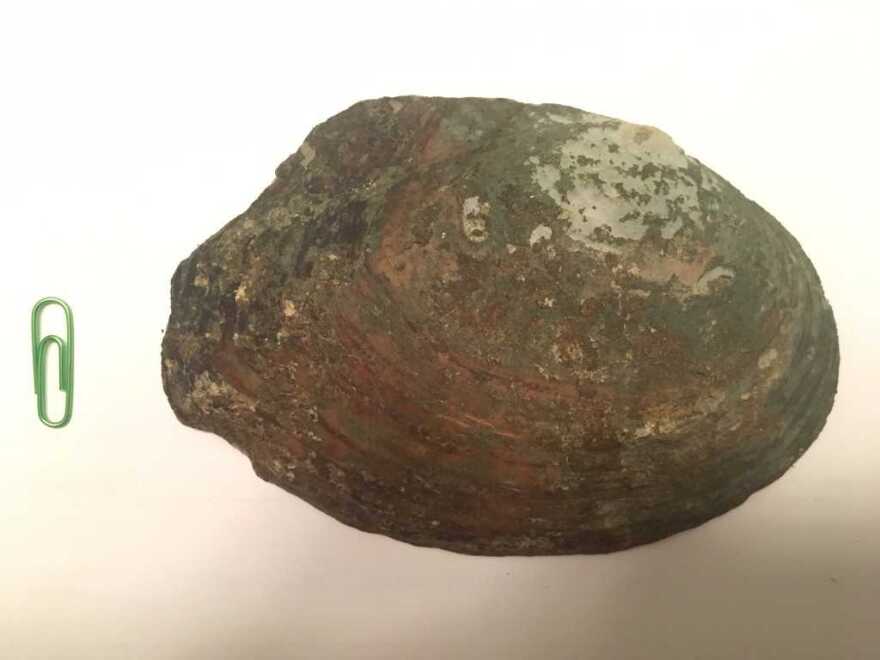Mussels may not be the first creature that comes to mind when you think about a healthy watershed. But unlike the invasive quagga and zebra mussels that have turned the Great Lakes ecosystem upside down, native freshwater varieties fill an important niche.
“They take contaminants out of the water, they take sediment out of the water. They take all stuff in and then they spit out what they don’t like,” says DNR conservation biologist, and mussel expert, Lisie Kitchel. “When they (mussels) spit that out it’s in the stuff called pseudo feces that goes onto the bottom and then that makes a food source available to bugs and crayfish that live on the bottom."
There are 51 species of mussels native to Wisconsin, more than halfare threatened.
Kitchel says when mussels decline, so do bugs and crayfish. The food chain is thrown out of whack.
Kitchel and fellow conservation biologist Jesse Weinzinger recently taught a group of volunteers how to carefully search for mussels.
They met on Cedar Creek, just north of Cedaburg in the heart of the Milwaukee River basin.

“So what we’ll do is get into groups of four. We’ll document the start time and then after 15 minutes we’ll all re-gather and identify everything we find,” Weinzinger says.
Groups dutifully form and slosh into position in clunky waders. They drop their heads and peer into what look to be plain old plastic buckets. They’re actually called bathyscopes.
“Which is a fancy name for a bucket with a hole and Plexiglas on the bottom, says Zac Driscoll with Milwaukee Riverkeeper. “ This allows you to see into the river a little bit easier and you can actually find some of these mussels because if you’re walking around the river, you might just think you ran into a rock instead of a mussel.”

Thanks to a growing network of citizen scientists, Milwaukee Riverkeeper monitors water quality at nearly 100 spots throughout the basin.
Driscoll said adding mussel information can add to the depth of the water quality data his organization has been gathering for more than a decade.
“We have about 90 volunteers that go out monthly and collect data… The nice thing about mussels is that they’re in the water for a longer period of time, so this gives us more information about how the water quality is doing over the long term compared to taking a single chemistry measurement one day,” Driscoll says.
Besides, he says the more he learns about mussels, the cooler they become. Some species are as small as a fingernail, others grow as big as dinner plates.

Then there’s what Driscoll calls their bizarre life cycles: "Most of them are parasitic – within their life cycle they release their eggs and sperm into the water. They become fertilized and they’ll actually attach on the gills of fish. From there they suck the blood of the fish and then they develop and fall off the fish and then they go back into the sediment and develop into adult mussels."
He says many mussels rely on specific fish species as their short-term host. “So that’s why they’re so endangered is that they rely on certain fish to actually have their life cycle. So if you wipe out the fish, you’re going to wipe out the mussel."

"If we are still finding the rare things, often sensitive species, that's a very good thing. As water quality improves, it is amazingly - mussel species will come back." DNR conservation biologist Lisie Kitchel.
Fledgling mussel monitors huddle around biologist Lisie Kitchel, who introduces them to their finds: exotic sounding mussels like the Wabash pigtoe, the White heelsplotter, along with the remains of an ellipse mussel.
She says it’s one of the mussels on the threatened list.
Over time, 12 different mussel species have been found in the Milwaukee River basin. On that day, the Riverkeeper crew spotted eight of the 12.
Kitchel and other advocates hope monitoring and cleanup efforts one day lead to a basin that is not only swimmable and fishable for humans, but hospitable to all 12 mussels species that have historically called the Milwaukee River Basin home.

Have an environmental question you'd like WUWM's Susan Bence to investigate? Submit below.
_



